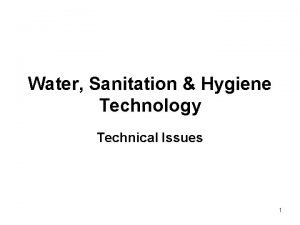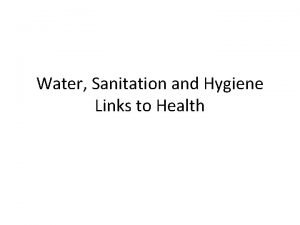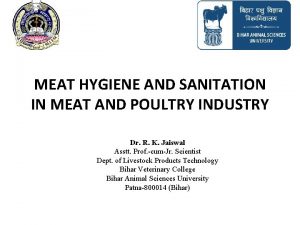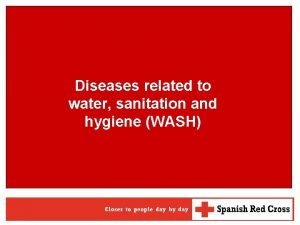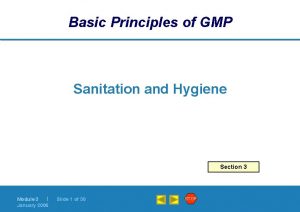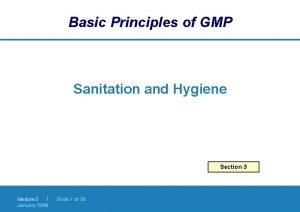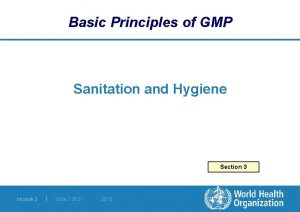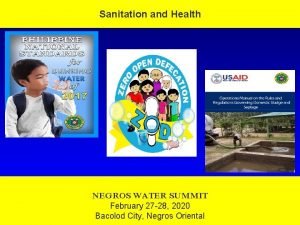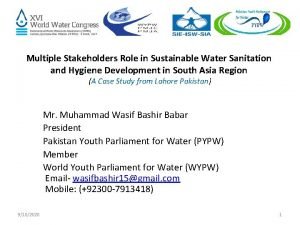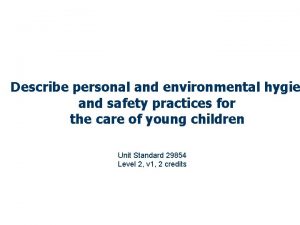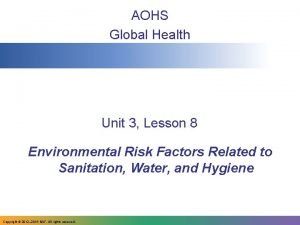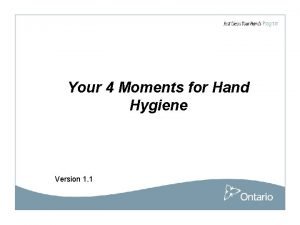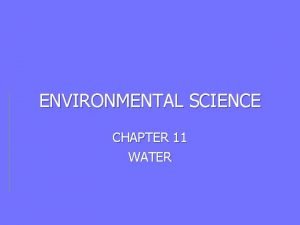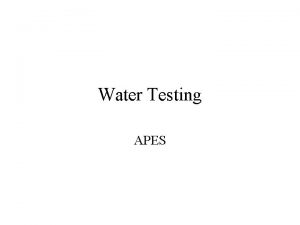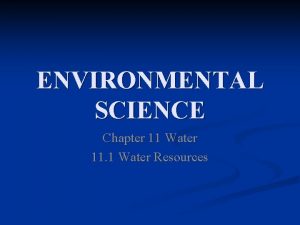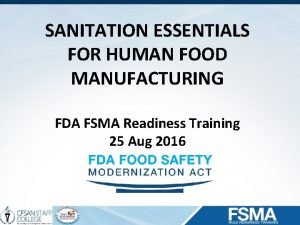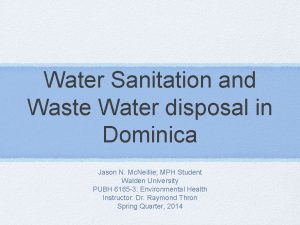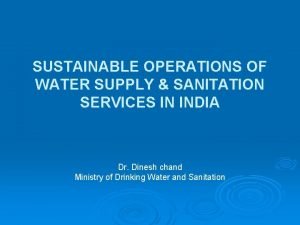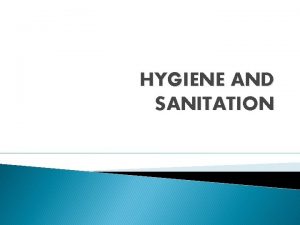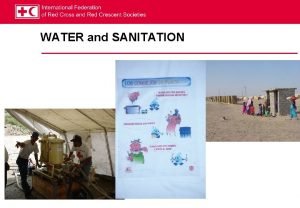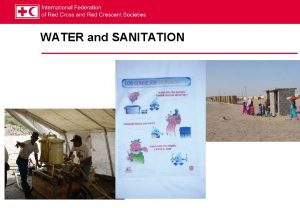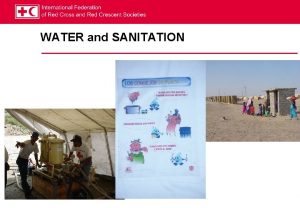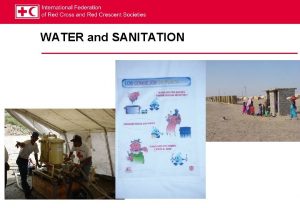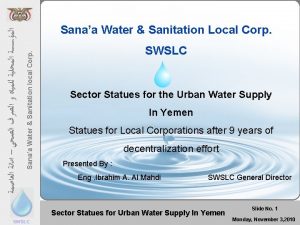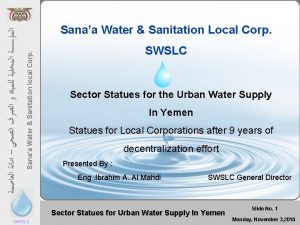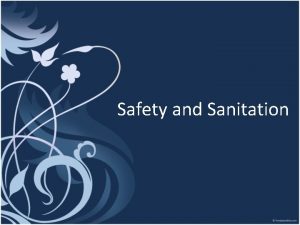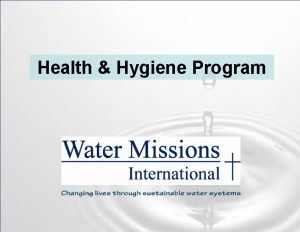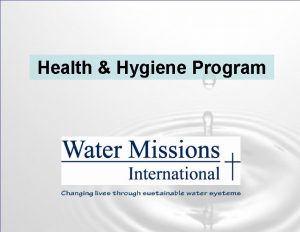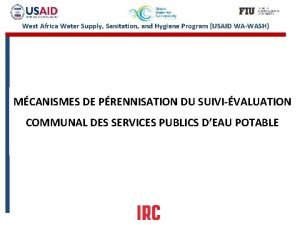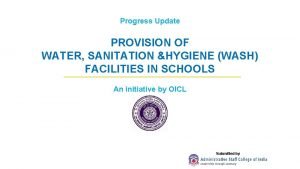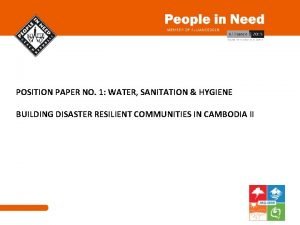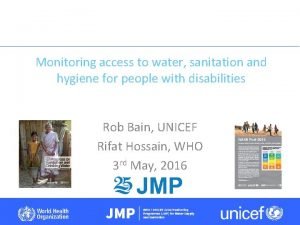Water sanitation hygiene environmental health Sanitation is the








![WATER SANITATION -CHEMICAL QUALITY CHEMICAL CONCENTRATION [mg/L] Arsenic 0. 2 Barium 1. 0 Cadmium WATER SANITATION -CHEMICAL QUALITY CHEMICAL CONCENTRATION [mg/L] Arsenic 0. 2 Barium 1. 0 Cadmium](https://slidetodoc.com/presentation_image_h2/900e6e692a4f8e003ad011bdf341b8cc/image-9.jpg)










![HOUSING SANITATION n CHARACTERISTICS OF AN ACCEPTABLE HOUSE…[cont]… n n n NOISE: SHOULD NOT HOUSING SANITATION n CHARACTERISTICS OF AN ACCEPTABLE HOUSE…[cont]… n n n NOISE: SHOULD NOT](https://slidetodoc.com/presentation_image_h2/900e6e692a4f8e003ad011bdf341b8cc/image-20.jpg)

![IN EMERGENCY SITUATIONS n WATER 1. MINIMUM REQUIREMENTS [. . CONT. . ] HOSPITALS IN EMERGENCY SITUATIONS n WATER 1. MINIMUM REQUIREMENTS [. . CONT. . ] HOSPITALS](https://slidetodoc.com/presentation_image_h2/900e6e692a4f8e003ad011bdf341b8cc/image-22.jpg)






- Slides: 28

Water, sanitation, hygiene & environmental health Sanitation is the hygienic means of promoting health through prevention of human contact with the hazards of wastes as well as the treatment and proper disposal of sewage or wastewater. Hazards can be physical, microbiological, biological or chemical agents of disease. Wastes that can cause health problems include human and animal excreta, solid

Definition and purposes (continued) Definition and purposes The World Health Organization explains sanitation as follows: "Sanitation generally refers to the provision of facilities and services for the safe disposal of human urine and feces. The word 'sanitation' also refers to the maintenance of hygienic conditions, through services such as garbage collection and wastewater disposal. " Sanitation includes all four of these engineering infrastructure items (even though often only the first one is strongly associated with the term "sanitation"): Excreta management systems, wastewater management systems (included here are wastewater treatment plants), solid waste management systems, drainage systems for rainwater, also called storm water drainage. n

Some water, sanitation and health numbers n Faecal-oral (focus of this presentation) n Diarrhoeal disease n 2 million deaths/year from diarrhoea, mostly under 5 n n n n Jumbo jet crash every hour and a half… One billion cases/year 4. 3% of Burden of Disease DALYs 88% (? ) attributable to inadequate WSH 1/3 of developing world pop’n carry intestinal worms 200 million infected by schistosomiasis (bilharzia) 6 -9 million blind from trachoma (1/4 reduced by adequate water supply)

Natural chemical hazards n Arsenic n n Skin lesions, various cancers “ 20 to 60” million exposed in Bangladesh Major problem other parts of S. Asia, also Argentina, Chile, China, Hungary, Mexico, Peru Fluorosis n n Dental damage, crippling bone damage “affects millions” (WHO) but often of mild form

COMPONENTS OF ENVIRNOMENTAL SANITATION n n n n WATER SANITATION FOOD AND MILK SANITATION EXCRETA DISPOSAL SEWAGE DISPOSAL REFUSE DISPOSAL VECTOR AND VERMIN CONTROL HOUSING AIR SANITATION

WATER SANITATION WATER ANALYSIS CONSISTS OF: n PHYSICAL n CHEMICAL n RADIOLOGICAL n BACTERIOLOGICAL

WATER Quality The relationship between water and health has been extensively studied. Drinking water should: 1. 2. 3. 4. 5. Be free from pathogenic (diseasecausing) organisms. Fairly clear (with low turbidity and little color). Not be saline (salty). Not contain compounds that cause an offensive taste or smell. Not contain chemicals, metals or radioactive compounds in concentrations that may have an adverse effect on human health.

Microbiological Quality of water The most important aspect of drinking water quality is its microbiological quality. Indicator bacteria of fecal contamination are thermtolerant (fecal) coliforms (E. coli), and fecal streptococci. When these bacteria are present in water, fecal contamination is indicated, and there is therefore a possibility that pathogenic bacteria and viruses are also present. n
![WATER SANITATION CHEMICAL QUALITY CHEMICAL CONCENTRATION mgL Arsenic 0 2 Barium 1 0 Cadmium WATER SANITATION -CHEMICAL QUALITY CHEMICAL CONCENTRATION [mg/L] Arsenic 0. 2 Barium 1. 0 Cadmium](https://slidetodoc.com/presentation_image_h2/900e6e692a4f8e003ad011bdf341b8cc/image-9.jpg)
WATER SANITATION -CHEMICAL QUALITY CHEMICAL CONCENTRATION [mg/L] Arsenic 0. 2 Barium 1. 0 Cadmium 0. 01 Chromium 0. 05 Cyanide 0. 01 Lead 0. 1 Selenium 0. 05 Silver 0. 05

WATER SANITATION n HOUSEHOLD TREATMENT OF WATER n n n BOILING, i. e. , beyond 2 minutes CHLORINATION- 1 -5 ppm IODINE TREATMENT- 10 drops per gallon FILTRATION AERATION

Sanitary Definitions n n Clean: Free of visible soil. Sanitize: Reduce the number of bacteria to a safe level. Sterilize: to make free of bacteria. Contamination: the presence of harmful substance in food.

Sanitation in the Food Industry n Sanitary (hygienic) practices in the food industry involve systematic control of environmental conditions during production, processing, storage, distribution, preparation, and consumption of foods and beverages. Such control includes ways to prevent contamination of products by microorganisms, insects, rodents, other animal pests, or foreign objects or chemicals. Hence, sanitary practices begin when raw materials are produced and continue until foods or beverages are consumed. Sanitary practices are

FOOD AND MILK SANITATION n The GOLDEN RULE of food sanitation is: “Keep it cold or hot, and keep it covered”

Factors Affecting the presence and concentration of pathogens in food n n n Temperature Moisture Nutrients PH Competitive flora

Why is it important to have a sanitary facility? To control pathogens and prevent foodborne illness: 1. Listeria monocytogenes 2. Salmonella 3. Staphylococcus aureus To control normal spoilage bacteria: 1. Yeast 2. Molds 3. Others that can cause economic spoilage and decrease shelf life n

Factors that contribute to a sanitary facility n n Facility design Equipment design Good cleaning and sanitizing procedures Good written sanitation programs and monitoring procedures

Historical evolution: water quality and health n n n John Snow Broad Street Pump 1854 Water Companies' Studies William Budd Typhoid in 1850's-60's Koch Cholera vs. Pettenkoffer Hamburg/Altona 1892 1937 Croydon Typhoid And many more…

Classifications of disease n n Classification usually by organism (viral, bacterial, etc) or organ (diseases of head, heart, liver etc. ) Classification by transmission route n n n Bradley’s great innovation in 1970 s If you know how it’s spread, you know how to stop it… …so engineers loved it!

The F-Diagramme Water supply Sanitation Fluids Hygiene Fingers Faeces Food Flies Fields/ Floors Future Victim
![HOUSING SANITATION n CHARACTERISTICS OF AN ACCEPTABLE HOUSEcont n n n NOISE SHOULD NOT HOUSING SANITATION n CHARACTERISTICS OF AN ACCEPTABLE HOUSE…[cont]… n n n NOISE: SHOULD NOT](https://slidetodoc.com/presentation_image_h2/900e6e692a4f8e003ad011bdf341b8cc/image-20.jpg)
HOUSING SANITATION n CHARACTERISTICS OF AN ACCEPTABLE HOUSE…[cont]… n n n NOISE: SHOULD NOT BE MORE THAN 30 DECIBELS ADEQUATE HEAT AND VENTILATION EQUIPPED WITH SANITARY TOILET, FOOD STORAGE AND PROPER REFUSE DISPOSAL

SANITATION REQUIREMENTS IN EMERGENCY SITUATIONS n 1. WATER MINIMUM DEMAND PERSON PER DAY A. 2 LTS FOR DRINKING B. 10 LTS FOR FOOD PREPARATION AND COOKING C. 15 LTS FOR BATHING D. 15 LTS FOR LAUNDRY E. 10 LTS FOR SANITATION AND HYGEINE …CONT…
![IN EMERGENCY SITUATIONS n WATER 1 MINIMUM REQUIREMENTS CONT HOSPITALS IN EMERGENCY SITUATIONS n WATER 1. MINIMUM REQUIREMENTS [. . CONT. . ] HOSPITALS](https://slidetodoc.com/presentation_image_h2/900e6e692a4f8e003ad011bdf341b8cc/image-22.jpg)
IN EMERGENCY SITUATIONS n WATER 1. MINIMUM REQUIREMENTS [. . CONT. . ] HOSPITALS AND CLINICS A. OUT-PATIENT: 5 LTS / PATIENT/ DAY. B. IN-PATIENT: 40 -60 LTS/ PATIENT/ DAY FEEDING CENTERS: 20 -30 LTS/PERSON/DAY

ENVIRONMENTAL SANITATION n THE MOST COMMON AND MOST PRACTICAL DISINFECTING AGENT FOR DRINKING WATER: OZONE B. SILVER C. UV RAYS D. CHLORINE A.

Results from Esrey, 1985 Type of Intervention All interventions No of Results 53 Median Reduction 22 Range Water quality 9 16 0 -90 Water availability 17 25 0 -100 Water quality and availability Excreta disposal 8 37 0 -82 10 22 0 -48 0 -100 (Esrey, S. A. et al. , WHO Bull, 63(4): 757 -772, 1985)

Esrey (1985) by disease Disease or infection Cholera No of results 11 Median reduction 41 Shigella 27 48 0 -81 Entamoeba histolytica Giardia lamblia 17 2 0 -80 10 0 0 -20 Range 0 -91

Esrey’s update in 1991 Intervention Water & San Rigorous All Studies No Med % reduct 7 20 2 30 Sanitation Water Quality and Quantity 11 22 22 16 5 2 36 17 Water Quality 7 17 4 15 Water Quantity 7 27 5 20 Hygiene 6 33 Esrey et al. , WHO Bull, 69(5): 609 -621 (1991)

Previous reviews: a–d Esrey SA et al. (1991) Bull WHO 69 (5): 609 -621 e Curtis V, Cairncross S (2003) Lancet Inf Dis 3: 275 -281. Taken from S. Cairncross RWSSTG BBL “ The Health Impact of Sanitation”, Aug 2004.

The F-diagramme revisited Water supply Sanitation Fluids Hygiene Fingers Faeces Food Flies Fields/ Floors Future Victim
 Sanitation and hygiene
Sanitation and hygiene Sanitation and hygiene
Sanitation and hygiene Poultry hygiene and sanitation
Poultry hygiene and sanitation Sanitation and hygiene
Sanitation and hygiene Gmp sanitation and hygiene
Gmp sanitation and hygiene Gmp sanitation and hygiene
Gmp sanitation and hygiene Gmp sanitation and hygiene
Gmp sanitation and hygiene Water and water and water water
Water and water and water water Environmental sanitation clearance
Environmental sanitation clearance Components of environmental sanitation
Components of environmental sanitation Stakeholders in water and sanitation
Stakeholders in water and sanitation What is personal and environmental hygiene
What is personal and environmental hygiene Unit 3 health and hygiene
Unit 3 health and hygiene 4 moments of hand hygiene ontario
4 moments of hand hygiene ontario Important of personal hygiene
Important of personal hygiene Body clean
Body clean Wireless health
Wireless health Chapter 11 review environmental science
Chapter 11 review environmental science Water quality tests apes
Water quality tests apes Water table environmental science
Water table environmental science Wa department of water and environmental regulation
Wa department of water and environmental regulation Concept school
Concept school Delvic sanitation initiatives
Delvic sanitation initiatives Master sanitation schedule examples
Master sanitation schedule examples Sanitation importance
Sanitation importance Shellfish sanitation program
Shellfish sanitation program Moeller sanitation
Moeller sanitation Conclusion on sanitation
Conclusion on sanitation Conclusion on sanitation
Conclusion on sanitation
